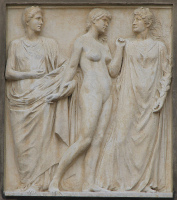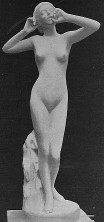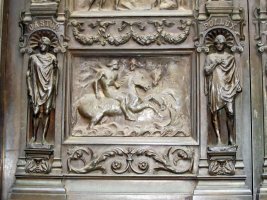Thomas Stirling Lee (1856-1916)
One of the St George's Hall panels by Stirling Lee.
The sculptor Thomas Stirling Lee studied sculpture abroad in Paris (1880-81) and then Rome (to 1883). He was apprenticed at to Birnie Phillip, then working on the Pantheon of sculpture for the Albert Memorial. He was just 25 years old when he succeeded in the competition to design plaques for St George's Hall in Liverpool, though this later proved a mixed blessing; see this page. Later critics were loud in their praise, however, with Spielmann calling them "the finest reliefs produced in this country; indeed, there are those who doubt if anything has been done in modern times in any country to excel them - there is no doubt that by these works alone, Mr Lee's name must live". He established his studio in Chelsea, in an area frequented by other artists, including William de Morgan and Ricketts and Shannon. He was one of the founder members of the New English Art Club, also the Chelsea Arts Club, and of the Royal Society of British Sculptors. He died rather suddenly and rather young in 1916.
The Echo, an allegorical figure by Stirling Lee.
The St George's Hall panels are the main example of his work as an architectural sculptor. Also in Liverpool, he modelled the bronze doors for the Adelphi Bank building, to the design of W. D. Caroe. Another set of doors with low relief figures by him is in Leeds, for the Cooperative bank. And his are the figures on the Lindley Clock Tower in Huddersfield. As well as architectural sculpture, Stirling Lee made a number of ideal works, including ideal nudes such as The Echo and The Dawn of Womanhood, altar pieces for churches, and some portrait sculpture. An example of a portrait statue by him is that of Bishop Gore, outside St Philip's Cathedral in Birmingham (see picture on this page).
Detail of the Adelphi Building door, Liverpool.
Stirling Lee's preference was for reliefs and medallions, and unusually, he generally carved directly on marble without help from assistants. His aim was on form and line and surface, but not so much on solid masses, perhaps suggesting his fondness for relief sculpture.


